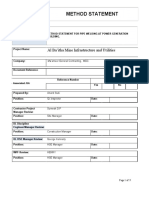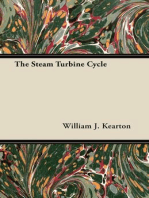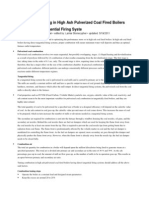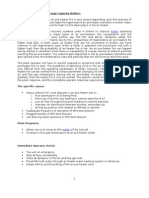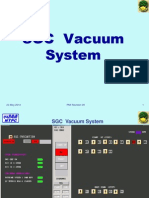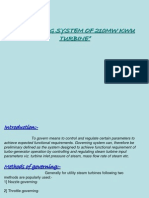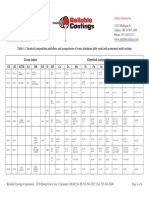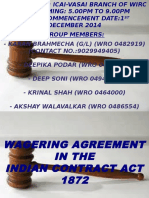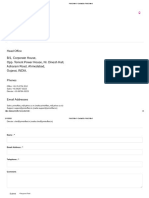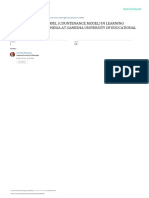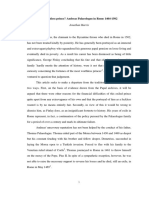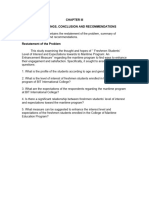Coal Mill in Thermal Power Plant
Coal Mill in Thermal Power Plant
Uploaded by
kiki270977Copyright:
Available Formats
Coal Mill in Thermal Power Plant
Coal Mill in Thermal Power Plant
Uploaded by
kiki270977Original Description:
Copyright
Available Formats
Share this document
Did you find this document useful?
Is this content inappropriate?
Copyright:
Available Formats
Coal Mill in Thermal Power Plant
Coal Mill in Thermal Power Plant
Uploaded by
kiki270977Copyright:
Available Formats
1.
COAL MILL/PULVERIZER IN THERMAL POWER PLANTS
Pulverized coal burns like gas, can be easily lighted and controlled. Pulverized coal
achieved its first commercial success in the cement industry. At Wisconsin Electric Power
Company, the use of pulverized coal was also shown to be a viable fuel for electrical power
production after World War I Coal continues to play a predominant role in the production of
electricity in the world, A very large percentage of the total coal is burned in pulverized
form.2. 1.Introduction
The pulverized coal and air mixture is then transport to the boiler burner panels. The coal
flow is controlled by the feeder, allowing coal to flow into the pulverizer mill. One of the
critical power plant components that is relied upon to convert the energy stored in coal into
electricity is the coal pulverizer or mill.3. 2.Coal pulverizer/mill system
4. 3.Boiler Boiler drum Reheater Final Super Platen Super heater heater LTSH Economizer
Coal bunker Wind Box Secondary PA duct air duct Furnace Flue gas APH duct Coal feeder F
D Fan P A Fan Coal Pulverizer
Classification Circulation Grinding Drying There are four primary principals
involved in pulverization: The pulverizer receives the raw coal and reduces it to a very fine,
specified size consist, similar to face powder.5. 4.Pulverizer
The inherent and surface moisture of the coal is reduced by the exposure to hot air. During
the pulverization process the surface area of the coal particles increases dramatically
exposing fresh coal to the entrainment air. The coal that is passing through a pulverizer is
entrained by the use of hot air usually from the air heater.6. 4.1.Drying
3. Attrition where material is ground by rubbing or friction 2. Crushing where material is
forced between two fixed objects 1. Impaction where the material to be ground is hit or
impacted by an outside force There are three basic types of grinding:7. 4.2.Grinding
The primary air, is the method of circulating the coal through the pulverizer. Circulating air is
also important in allowing for the removal of heavy material such as pyrites, extraneous
metal, etc. by centripetal force that otherwise might damage the grinding mechanisms.8.
4.3.Circulation
The classifier, located on the top of a mill returns the over-size material back to the
pulverizer but allows the proper-sized material to pass out of the mill to the burners.
classifiers are critical in providing the desired quality of pulverized coal with the desired
fineness The circulating air is also used to classify the pulverized coal product prior to
carrying it to the burners.9. 4.4.Classification
10. 5.Types of PulverizersSpeed Low Medium High 10 to 20 40 to 70 900 to rpm rpm 1000
rpmType Ball tube Bowl Hammer mill Ball & race mill millDominating Attrition Crushing
Impactprinciple
11. 6.C-E Raymond Bowl Mill BOWL MILL
12. 7.Ball and race mill
13. 8.Foster Wheeler MBF Mill
14. 9.Tube Mill
Centrifugal force feeds the coal uniformly over the replaceable grinding ring where
independently spun rolls exert the required grinding pressure. The rolls do not touch the
grinding ring even when the mill is empty. Crushed raw coal at a controlled rate is fed into
the revolving bowl of the Bowl Mill. The mill output can be easily varied, as per the turndown
ratio from its minimum to maximum load. Bowl mills are employed to pulverize the precrushed raw coal to the required fineness before it is admitted into the boiler furnace for
combustion.15. 10.Bowl Mill
16. 10.1.Designation of C-E Bowl Mills
17. 11.Bowl Mill Grinding rolls
18. 12.Pulveriserfor 500 MW1. TYPE- XRP 10032.NO OF MILL- 103.CAPACITY - 62.9
T/HR4.MOTOR 525 KW5.SPEED - 600 RPM
REJECTS CAPACITY, COAL GRINDABILITY, FINENESS,19. 13. Mill Performance
Criteria
In addition, coal retained on the 50 mesh screen should be in the 12% range. Higher
values indicate worn internals or improper settings. Also, the higher percentages can cause
boiler slagging and high unburned carbon. Values lower than 70% mean higher carbon loss
and increased fuel consumption. The mill wear and the power consumption are increased if
the 70% value is exceeded. A 70% coal sample passing through a 200 mesh screen
indicates optimum mill performance. Fineness is an indicator of the quality of the pulverizer
action. Specifically, fineness is a measurement of the percentage of a coal sample that
passes through a set of test sieves usually designated at 50, 100, and 200 mesh20.
13.1.Fineness
21. 13.2.Sieve distribution chart & Fineness testingscreen - Plot of coal fineness on Fineness
testing screen Rosin and Rammler
Figure shows the effect of coal grindability (HGI) and desired fineness (percent passing a
200 mesh screen) on the mill capacity.22. 13.3.Mill capacity vs Grindability
The dashed line estimates the increase in mill capacity in going from a high-volatile B
bituminous coal with a 55 HGI, 12% moisture and a desired mill output of 70% through a 200
mesh screen to a highvolatile B bituminous coal with an HGI value of 60, a moisture content
of 14% and the same fineness. Figure demonstrates how moisture and grindability affect
pulverizer capacity. 23. 13.4.Moisture and grindabilityeffects on mill capacity
However, it is not economical to attempt to grind and burn pyrites Pyrites are the common
mineral iron disulfide (FeS2) that has a pale brass-yellow color and metallic luster. The
amount of pulverizer rejects is one indication of mill performance.24. 13.5.Mill Rejects &
Pyrite Scraper and Guard Assembly rock.
25. 13.6. Grindability Index, Moisture, Fineness vs mill capacity (XRP 883 Bowl mill) Design
parameters Mill capacity- 42.48 T/HR Total moisture-10% HGI -50
26. 13.7.Logic tree Mill Fineness Decrease in mill fineness SIEVE TEST RESULTS 70%
THRU 200 MESH 99.2% THRU 50 MESHClassifier Loss of Ring or Classifier Exceeding
Vane Roller Roller Vane Millposition tension wear wear capacity
carbides in the metal part, High chromium cast iron materials are used for improved
abrasion resistance. Worn Journal Roll In coal pulverization, 520% of the material being
crushed is abrasive mineral. Coal is not abrasive by itself. The minerals in coal that are the
most abrasive are quartz and pyrite, which cause a abrasion or severe wear.27.
14.Abrasion in pulverizer
P = 0.1 % max S = 0.1 % max Si = 0.5 1.0 % Mn = 1.0 2.0 % W = 1.0 2.0% Mo
= 1.0 2.0 % Cr = 15.0 22.0 % C = 2.6 3.0 % CHEMICAL COMPOSITION OF THE
INSERTS: This specification of high chrome white cast iron inserts for making Insert
Grinding Rolls.28. 14.1.CHEMICAL COMPOSITION OF THEINSERTS GRINDING ROLLS
There has been success in the industry using ceramic materials. Classifier cone with
ceramic Erosion can produce holes in steel liners and deep depressions in large section
cast parts. Erosion by mineral particles picked up in the air stream carrying pulverized coal
through the mill, classifier, exhauster, and transport pipe is a recognized problem.29.
15.Erosion in Pulverizer
The startup procedures, in addition to the controls and interlocks, should follow the
requirements of NFPA 85.30. 16.Startup Procedures
Any other test recommended by OEM. Sediment in Lubricating Oils Condition of oil
additives Total acid measure Viscosity Particle count Lubricant Oil analysis Vibration
analysis , The main technologies used in condition monitoring are:31. 17.Condition
Monitoring
Air in-leakage sources Feeder settings Pyrite rejects chute and/or damper condition
Pyrite scraper clearance Spring pressure for rolls Grinding roll-to-bowl clearance
Journal assembly condition Inverted cone clearance Deflector ring length Classifier
internal condition Following inspection parameters are critical for bowl mill
performance:32. 18.Inspection
Effect of changes in pulverizer component settings on product fineness, pulverizer capacity,
and power consumption. Capacity, Fineness of product, Raw coal feed, Grindability,
Moisture, Sizing, Power consumption and Effect of changes in raw coal Characteristics on
product fineness, pulverizer capacity, and power consumption. The purpose of this code is
to establish procedures for conducting performance tests to determine:33. 19.Test code of
Pulverizer::ASME PTC 4.2
34. THANKING YOU
35. Logic tree Mill Fineness Decrease in mill fineness SIEVE TEST RESULTSClassifier
Loss of Ring or Classifier Exceeding Vane Roller Roller Vane Millposition tension wear wear
capacity
You might also like
- Method Statement WeldingDocument9 pagesMethod Statement Weldingkiki270977No ratings yet
- Method Statement WeldingDocument9 pagesMethod Statement Weldingkiki270977No ratings yet
- Coal Mill Performance OptimisationDocument11 pagesCoal Mill Performance OptimisationSaurabh KumarNo ratings yet
- Coal Mill Sealing Air SystemDocument7 pagesCoal Mill Sealing Air SystemMahmoud Mohammad100% (1)
- Quality Bowl MillsDocument3 pagesQuality Bowl MillsJimit ShahNo ratings yet
- Ade MillsDocument47 pagesAde Millsanon_787758227100% (1)
- MilsDocument97 pagesMilsKomma Ramesh100% (1)
- 02.case Study On Boiler Tube Failure at JPLDocument8 pages02.case Study On Boiler Tube Failure at JPLAnonymous XBq5J84No ratings yet
- Soot BlowingDocument11 pagesSoot BlowingHoncho Abhi SinhaNo ratings yet
- MPSP Mill - Simhadri1Document18 pagesMPSP Mill - Simhadri1santoshkumar777No ratings yet
- Power Plant FansDocument66 pagesPower Plant FansSooperAktif100% (1)
- Analysis of Feed WaterDocument9 pagesAnalysis of Feed Watersanju0156100% (3)
- Combustion Tuning in High Ash Pulverized Coal Fired Boilers Having Direct Tangential Firing SysteDocument2 pagesCombustion Tuning in High Ash Pulverized Coal Fired Boilers Having Direct Tangential Firing SysteraghuveeranushNo ratings yet
- Bowel Mill Inspection Guide LineDocument10 pagesBowel Mill Inspection Guide Linesen_subhasis_58No ratings yet
- Tanda ReportDocument34 pagesTanda ReportRamanand bharadwajNo ratings yet
- A Study On Boiler Efficiency Improvement by Controlling Flue Gas Heat LossesDocument9 pagesA Study On Boiler Efficiency Improvement by Controlling Flue Gas Heat Lossespriyajit sahooNo ratings yet
- Aph FireDocument25 pagesAph Firesekhar_ntpcNo ratings yet
- Air PreheatersDocument21 pagesAir PreheatersVinay DimriNo ratings yet
- Burner Tilt PDFDocument9 pagesBurner Tilt PDFEE POG-III CSTPSNo ratings yet
- Ash Handling SystemDocument24 pagesAsh Handling SystemAyan Maji100% (1)
- Boiler EfficiencyDocument24 pagesBoiler EfficiencyAmit ChauhanNo ratings yet
- Coal Air FlowDocument3 pagesCoal Air FlowtaylhorNo ratings yet
- Jindal Power Limited O.P.J.S.T.P.P, Tamnar, Raigarh: Commissioning DepartmentDocument9 pagesJindal Power Limited O.P.J.S.T.P.P, Tamnar, Raigarh: Commissioning Departmentjp mishraNo ratings yet
- Condensate System PresentationDocument24 pagesCondensate System Presentationмing junNo ratings yet
- Boiler Tube LeakageDocument20 pagesBoiler Tube LeakageSayan AichNo ratings yet
- IAC PAC Power Plant BarhDocument19 pagesIAC PAC Power Plant BarhMohammad AtaullahNo ratings yet
- Air Preheater Washing ProtocolDocument3 pagesAir Preheater Washing ProtocolSony Rama0% (1)
- Sliding Pressure OperationDocument29 pagesSliding Pressure OperationvesridharNo ratings yet
- CH 7 Paper 5 Flue Gas Temp Optimisation - Vindhyachal - ActualDocument6 pagesCH 7 Paper 5 Flue Gas Temp Optimisation - Vindhyachal - ActualSamNo ratings yet
- Coal Milling System Gyanendra Sharma NPTI DelhiDocument79 pagesCoal Milling System Gyanendra Sharma NPTI DelhiNPTINo ratings yet
- Power Station FansDocument70 pagesPower Station FansShubham Verma100% (1)
- Paper4 Mill RejectDocument39 pagesPaper4 Mill Rejectnetygen1No ratings yet
- Turbo Supervisory SystemDocument41 pagesTurbo Supervisory SystemJagadeesan SaiNo ratings yet
- Salient Features of 500MWDocument63 pagesSalient Features of 500MWSamNo ratings yet
- CFBC Boiler Gyanendra Sharma NPTI DelhiDocument47 pagesCFBC Boiler Gyanendra Sharma NPTI DelhiNPTI100% (1)
- Mill & Mill Rejects WriteupDocument10 pagesMill & Mill Rejects WriteupEXECUTIVE ENGINEEER BOILER MAINTENANCENo ratings yet
- Coal MillDocument37 pagesCoal MillVinayak Unaune100% (1)
- APH Guide Bearing FailureDocument5 pagesAPH Guide Bearing FailureParmeshwar Nath Tripathi0% (1)
- Coal Mill Startup and ShutdownDocument6 pagesCoal Mill Startup and ShutdownAnonymous W9VINoTzaNo ratings yet
- 210 MW PowerplantDocument63 pages210 MW PowerplantPratik Makwana100% (6)
- Coal Feeding System (Coal Bunkers, RC Feeders & Coal Mills) : Dipti Ranjan Behera Manager (Elect)Document15 pagesCoal Feeding System (Coal Bunkers, RC Feeders & Coal Mills) : Dipti Ranjan Behera Manager (Elect)Sanjay GuptaNo ratings yet
- Ash Handling System: in A 210 M.W Boiler, The Coal Consumption Is 3,500 M.T S Per Day The Ash Content Is 1,400 M.T SDocument22 pagesAsh Handling System: in A 210 M.W Boiler, The Coal Consumption Is 3,500 M.T S Per Day The Ash Content Is 1,400 M.T Sprasi1010No ratings yet
- CFBC Boiler Start Up ProblemsDocument40 pagesCFBC Boiler Start Up ProblemsarvindshuklaNo ratings yet
- 3 SGC VacuumDocument9 pages3 SGC VacuumSam100% (1)
- Heat Rate of TG PDFDocument9 pagesHeat Rate of TG PDFTapash Nag0% (1)
- WelcomeDocument80 pagesWelcomeAhemad100% (2)
- Boiler Silica Carry OverDocument18 pagesBoiler Silica Carry OverAslamNo ratings yet
- Industrial Training Project Report (SECURED) PDFDocument192 pagesIndustrial Training Project Report (SECURED) PDFAshish UppuNo ratings yet
- NTPC 500 Power Plant Operation Pipe LineDocument84 pagesNTPC 500 Power Plant Operation Pipe LineJoselin Leo100% (1)
- BHEL Steam TurbinesDocument23 pagesBHEL Steam TurbinesVikas100% (2)
- Governing System of 210mw KwuDocument21 pagesGoverning System of 210mw KwuNitesh Rasekar100% (5)
- Super-Critical BoilerDocument67 pagesSuper-Critical BoilerPrakash PatelNo ratings yet
- Line TraceDocument84 pagesLine TraceSam100% (1)
- Difficulties FacedDocument6 pagesDifficulties FacedAnonymous pKsr5vNo ratings yet
- CMCDocument34 pagesCMCtauqir123100% (2)
- Turbine Issues ResolutionDocument34 pagesTurbine Issues Resolutionraj3880% (5)
- Fans in Thermal Power PlantsDocument3 pagesFans in Thermal Power PlantsMuhammad Nadeem RazaNo ratings yet
- A Case Study On-Shutdown Audit of AFBC BoilerDocument12 pagesA Case Study On-Shutdown Audit of AFBC BoilerSelvakumar Palaniandavar100% (2)
- 200 MWDocument36 pages200 MWphilocloudNo ratings yet
- Coal-Mill Optimisation in Coal-Fired Power Stations Aids FlexibilityDocument9 pagesCoal-Mill Optimisation in Coal-Fired Power Stations Aids FlexibilityTinyiko S. MalulekeNo ratings yet
- Elearning Course Title - Project - Budgeting and Capital Budgeting Management 479387Document1 pageElearning Course Title - Project - Budgeting and Capital Budgeting Management 479387kiki270977No ratings yet
- Welding Procedure Specificaton (WPS)Document2 pagesWelding Procedure Specificaton (WPS)kiki270977100% (1)
- WPS 01 WQT PDFDocument1 pageWPS 01 WQT PDFkiki270977No ratings yet
- WPS 01 WQTp2 PDFDocument1 pageWPS 01 WQTp2 PDFkiki270977No ratings yet
- Pipe Support Sleeve PEDocument2 pagesPipe Support Sleeve PEkiki270977No ratings yet
- APS3 Automated Pipe ScannersDocument2 pagesAPS3 Automated Pipe Scannerskiki270977No ratings yet
- AGS 1 Automated General Purpose ScannerDocument2 pagesAGS 1 Automated General Purpose Scannerkiki270977No ratings yet
- Bohler Fox S Ev 50: Stick Electrode, Unalloyed BasicDocument1 pageBohler Fox S Ev 50: Stick Electrode, Unalloyed Basickiki270977No ratings yet
- AGS 2 Automated General Purpose ScannerDocument2 pagesAGS 2 Automated General Purpose Scannerkiki270977No ratings yet
- APS6 Automated Pipe ScannerDocument2 pagesAPS6 Automated Pipe Scannerkiki270977No ratings yet
- Submersible Pumpset For 200Mm Borewell (V6 - V8 Combination - 183Mm Od) Radial FlowDocument2 pagesSubmersible Pumpset For 200Mm Borewell (V6 - V8 Combination - 183Mm Od) Radial Flowkiki270977No ratings yet
- Fitter ProfileDocument1 pageFitter Profilekiki270977No ratings yet
- 1 Advertisement PDFDocument1 page1 Advertisement PDFkiki270977No ratings yet
- Welder ProfileDocument1 pageWelder Profilekiki270977No ratings yet
- Cable Size Calculations SpreadsheetDocument4 pagesCable Size Calculations Spreadsheetkiki270977No ratings yet
- Miter Bend CalculationDocument1 pageMiter Bend Calculationkiki270977No ratings yet
- Alloy Conversion ChartsDocument4 pagesAlloy Conversion Chartskiki270977No ratings yet
- ICD-MX20: Memory Stick® Pro™ Duo Digital Voice RecorderDocument2 pagesICD-MX20: Memory Stick® Pro™ Duo Digital Voice RecorderFurhana AfridNo ratings yet
- REPUBLIC ACT NO 9298-Revised Accountancy LawDocument12 pagesREPUBLIC ACT NO 9298-Revised Accountancy LawHar ŔhýmNo ratings yet
- 94 Prof Moeller Summary enDocument18 pages94 Prof Moeller Summary enaptureincNo ratings yet
- DMCC Approved License Activity Sheet 2020Document368 pagesDMCC Approved License Activity Sheet 2020YOGESH SONINo ratings yet
- WageringDocument28 pagesWageringAnonymous gIxIDbmNo ratings yet
- Print Offset - Contact To Print OffsetDocument4 pagesPrint Offset - Contact To Print OffsetSunil PatelNo ratings yet
- Sustainable Development As Freedom: Trends and Opportunities For The Circular Economy in The Human Development LiteratureDocument26 pagesSustainable Development As Freedom: Trends and Opportunities For The Circular Economy in The Human Development LiteratureLuiz Vicente NetoNo ratings yet
- LCM 60DA SpecDocument8 pagesLCM 60DA SpecAlex FilipovicNo ratings yet
- Check List For BTSDocument1 pageCheck List For BTSWin LinnNo ratings yet
- Materi Demand Planning (Peserta)Document24 pagesMateri Demand Planning (Peserta)andhikawidi.telkomsigmaNo ratings yet
- Stake Evaluation Model (Countenance Model) in Learning Process Bahasa Indonesia at Ganesha University of EducationalDocument12 pagesStake Evaluation Model (Countenance Model) in Learning Process Bahasa Indonesia at Ganesha University of EducationalArie AnggaNo ratings yet
- Dev. 9-Garden and Landscape.: DescriptionDocument9 pagesDev. 9-Garden and Landscape.: DescriptionrafabdNo ratings yet
- Rudolph ("Rudy") William Louis Giuliani Ethics Complaint - RedactedDocument3 pagesRudolph ("Rudy") William Louis Giuliani Ethics Complaint - RedactedAlbert cahn100% (2)
- A Worthless Prince Andreas Palaeologus in Rome by Jonathan HarrisDocument27 pagesA Worthless Prince Andreas Palaeologus in Rome by Jonathan HarrisSalah ZyadaNo ratings yet
- Agricultural Extension MSC SyllabusDocument14 pagesAgricultural Extension MSC Syllabuspradosh kumar routNo ratings yet
- Assignment 3Document4 pagesAssignment 3May AlgallaiNo ratings yet
- Low Power RTL Design TechniquesDocument20 pagesLow Power RTL Design Techniquesmuhammedayman350No ratings yet
- Management Information System AssignmentDocument3 pagesManagement Information System Assignmentgimefo9325No ratings yet
- Modules To Run CTSDocument3 pagesModules To Run CTSsubscribe.deepakgNo ratings yet
- ElectroluxDocument3 pagesElectroluxSyed Noman AhmedNo ratings yet
- VWW IMO Witherby Ebook User Guide V2.0Document15 pagesVWW IMO Witherby Ebook User Guide V2.0Макс АртюхNo ratings yet
- MPID Act Rana Case Judgment Nagpur BenchDocument26 pagesMPID Act Rana Case Judgment Nagpur BenchAnand BhautikNo ratings yet
- Report of The Auditor-General On The Public Accounts of Ghana - Ministries, Departments and Other Agencies For The Year Ended 31 December 2021Document212 pagesReport of The Auditor-General On The Public Accounts of Ghana - Ministries, Departments and Other Agencies For The Year Ended 31 December 2021ogbarmey-tettey andyNo ratings yet
- Incident Notification Form FORM COR HSE 105 E R04Document2 pagesIncident Notification Form FORM COR HSE 105 E R04naga74petrojetNo ratings yet
- CITC Technical Specification: Document Number: RI033 Revision: Issue 2 Date: 10/01/2010 GDocument4 pagesCITC Technical Specification: Document Number: RI033 Revision: Issue 2 Date: 10/01/2010 Gkalligadu_143No ratings yet
- CM402-Part 4 - Worksheet 7-2023-24Document9 pagesCM402-Part 4 - Worksheet 7-2023-24Prum NorarNo ratings yet
- Field CommunicationsDocument7 pagesField CommunicationsSameer NaeemNo ratings yet
- Restatement of The ProblemDocument8 pagesRestatement of The Problemmercadosandra804No ratings yet
- Vivens 1Document27 pagesVivens 1Dushimiyimana jean EudeNo ratings yet
- MATERIALDocument1 pageMATERIALSunil KoolwalNo ratings yet

